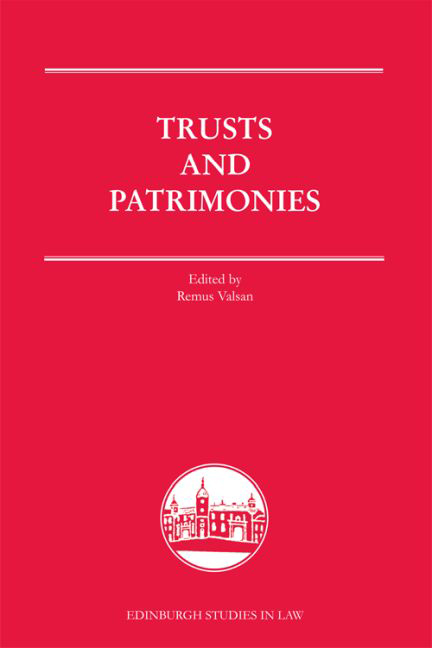Book contents
- Frontmatter
- Contents
- Preface and Acknowledgements
- List of Contributors
- List of Abbreviations
- Table of Cases
- INTRODUCTION
- PART I PATRIMONY AND THE COMMON LAW TRUST
- PART II PATRIMONY AND THE SCOTTISH TRUST
- PART III TRUST AND PATRIMONY IN FRANCE, QUEBEC AND THE NETHERLANDS
- 8 Translating Part of France's Legal Heritage: Aubry and Rau on the Patrimoine
- 9 Trusting Patrimonies
- 10 Dual Patrimony Dutch Style: The Magic Spell for Introducing the Trust in the Netherlands?
- Index
10 - Dual Patrimony Dutch Style: The Magic Spell for Introducing the Trust in the Netherlands?
from PART III - TRUST AND PATRIMONY IN FRANCE, QUEBEC AND THE NETHERLANDS
Published online by Cambridge University Press: 15 September 2017
- Frontmatter
- Contents
- Preface and Acknowledgements
- List of Contributors
- List of Abbreviations
- Table of Cases
- INTRODUCTION
- PART I PATRIMONY AND THE COMMON LAW TRUST
- PART II PATRIMONY AND THE SCOTTISH TRUST
- PART III TRUST AND PATRIMONY IN FRANCE, QUEBEC AND THE NETHERLANDS
- 8 Translating Part of France's Legal Heritage: Aubry and Rau on the Patrimoine
- 9 Trusting Patrimonies
- 10 Dual Patrimony Dutch Style: The Magic Spell for Introducing the Trust in the Netherlands?
- Index
Summary
GENERAL INTRODUCTION
Trusts have long been considered to be contrary to the Netherlands’ legal principle of numerus clausus of rights in rem. For this reason, the introduction of a trust has been regarded as impossible for many years. This chapter will discuss the possibility of conceptualising a Dutch trust using the dual patrimony theory, that is, the concept where a person, natural or legal, holds two patrimonies that are distinct from each other. In Dutch law, however, the term “dual patrimony” would cause great confusion: the principle is that a person can have only one patrimony, to which all his assets belong. However, a part of that patrimony can be – to remain close to Dutch legal terminology – separate from the rest. This means that the person's private creditors cannot recover their debts from these assets. For this reason, in the following, I prefer to use “separate patrimony” instead of “dual patrimony”.
First, the main obstacles in Dutch law for the introduction of a trust will be set out. Second, it will be explained how these obstacles have been partly overcome over the years and how the doctrine of separate patrimony could possibly lead to a definitive solution. Several instruments leading to a separate patrimony will be described. Third, some issues that could arise even if the trust were considered to be a separate patrimony will be touched upon, and a possible solution will be proposed. It is concluded that the doctrine of separate patrimony might be a good step in the right direction, but several other steps will need to be taken for the trust to be introduced in the Dutch Civil Code.
OBSTACLES FOR THE INTRODUCTION OF A TRUST IN THE NETHERLANDS
Indivisibility of ownership
In the continental view, the division of ownership rights into legal ownership and equitable ownership is considered an essential element of the trust and is generally characterised as “dual ownership”. In the old continental legal tradition, dual ownership was not uncommon. For example, in the case of usufruct, it was distinguished between “inferior ownership” or dominium utile and a “superior ownership” or dominium directum.
- Type
- Chapter
- Information
- Trusts and Patrimonies , pp. 221 - 243Publisher: Edinburgh University PressPrint publication year: 2015



